Related Research Articles
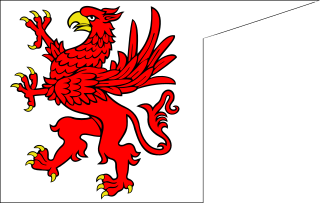
The Duchy of Pomerania was a duchy in Pomerania on the southern coast of the Baltic Sea, ruled by dukes of the House of Pomerania (Griffins). The country had existed in the Middle Ages, in years 1121–1160, 1264–1295, 1478–1531 and 1625–1637.
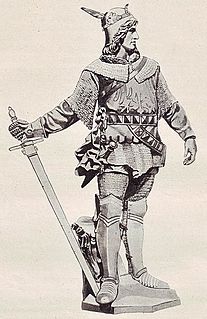
Waldemar the Great, a member of the House of Ascania, was Margrave of Brandenburg-Stendal from 1308 until his death. He became sole ruler of the Margraviate of Brandenburg upon the death of his cousin John V of Brandenburg-Salzwedel in 1317. Waldemar is known as the last in the line of Ascanian margraves starting with Albert the Bear in 1157; he was only succeeded by his minor cousin Henry II, who died one year later.
The House of Griffin or Griffin dynasty was a dynasty ruling the Duchy of Pomerania from the 12th century until 1637. The name "Griffins" was used by the dynasty after the 15th century and had been taken from the ducal coat of arms. Duke Wartislaw I was the first historical ruler of the Duchy of Pomerania and the founder of the Griffin dynasty. The most prominent Griffin was Eric of Pomerania, who became king of the Kalmar Union in 1397, thus ruling Denmark, Sweden and Norway. The last Griffin duke of Pomerania was Bogislaw XIV, who died during the Thirty Years' War, which led to the division of Pomerania between Brandenburg-Prussia and Sweden. Duchess Anna von Croy, daughter of Duke Bogislaw XIII and the last Griffin, died in 1660.
Barnim I the Good from the Griffin dynasty was a Duke of Pomerania from 1220 until his death.
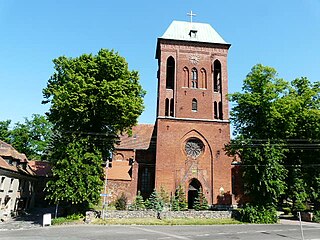
The Bishopric of Cammin was both a former Roman Catholic diocese in the Duchy of Pomerania from 1140 to 1544, and a secular territory of the Holy Roman Empire (Prince-Bishopric) in the Kolberg (Kołobrzeg) area from 1248 to 1650.

Wartislaw III was a Griffin duke of Pomerania-Demmin. Son of Casimir II of Pomerania-Demmin and Ingardis of Denmark, he was married to a Sophia of an unknown house. As he did not have any children, Pomerania-Demmin ceased to exist with his death.

The Principality of Rügen was a Danish principality, formerly a duchy, consisting of the island of Rügen and the adjacent mainland from 1168 until 1325. It was governed by a local dynasty of princes of the Wizlawiden dynasty. For at least part of this period, Rügen was subject to the Holy Roman Empire.
The County of Gützkow was a county in the Duchy of Pomerania in the High Middle Ages. It was established in 1129 from the Castellany of Gützkow. Following the death of its last count in 1359, it was reestablished into the Vogtei Gützkow.

Circipania was a medieval territory in what is now northeastern Germany. The name derives from Latin circum (around) and Pane. The region was enclosed roughly by the upper Recknitz, Trebel and Peene rivers, the western border ran east of Güstrow. The region developed in the 10th and 11th centuries, when it was the tribal territory of the Circipanes, a West Slavic tribe which along with the neighboring tribes was a part of the Lutici federation. The main burghs were Teterow, Malchin, and Demmin.

Pomerania during the High Middle Ages covers the history of Pomerania in the 12th and 13th centuries.

Pomerania during the Late Middle Ages covers the history of Pomerania in the 14th and 15th centuries.

Bogisław VIII, a member of the House of Griffins, was Duke of Pomerania ruling in Pomerania-Stolp from 1395 until his death. He also served as administrator of the Prince-Bishopric of Cammin from 1387 and as Cammin Prince-bishop from 1394 to 1398.

John Frederick was Duke of Pomerania from 1560 to 1600, and Bishop of Cammin (Kamień) from 1556 to 1574. Elected bishop in 1556 and heir of the duchy in 1560, he remained under tutelage of his great-uncle Barnim XI until he took on his offices in 1567.
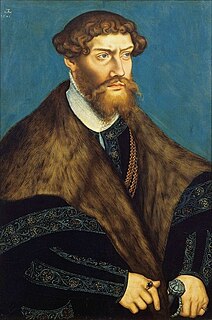
Philip I of Pomerania was Duke of Pomerania-Wolgast.

Casimir VI was a member of the House of Pomerania who ruled as Lutheran Administrator of the Prince-Bishopric of Cammin.
Swantibor I, previously referred to by historians as Swantibor III was a member of the House of Griffins, a Duke of Pomerania-Stettin and for a while governor of the Mittelmark.

John I, Margrave of Brandenburg was from 1220 until his death Margrave of Brandenburg, jointly with his brother Otto III "the Pious".

Nicholas I, Lord of Werle, was Lord of Rostock from 1229 to 1234 and Lord of Werle from 1234 until his death.
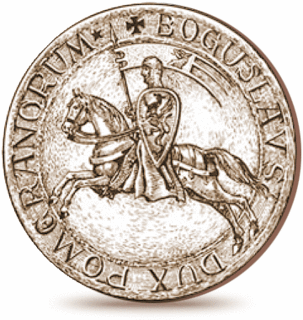
Bogislaw II was Duke of Pomerania-Stettin from 1187 until his death.
References
- Theodor Pyl (1881), "Jaczo I.", Allgemeine Deutsche Biographie (ADB) (in German), 13, Leipzig: Duncker & Humblot, pp. 633–636 (mentions Conrad as Jaczo's son)
- Martin Wehrmann: Geschichte von Pommern, vol. 1, Weltbild Verlag, 1992, reprint of an edition published in 1919 and 1921, ISBN 3-89350-112-6, p. 100–101